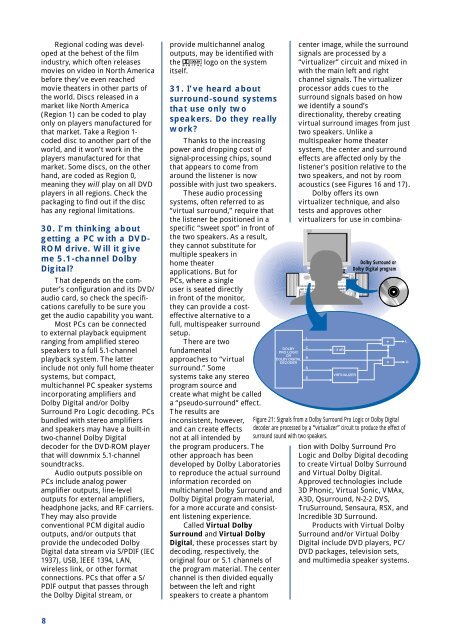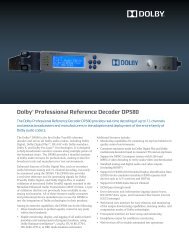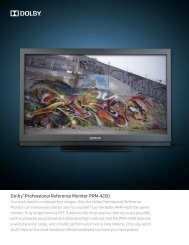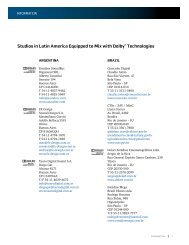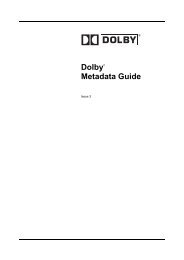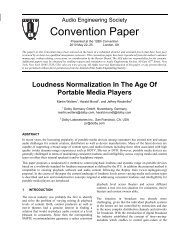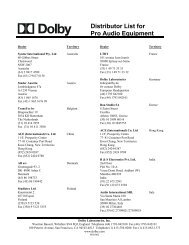Frequently asked QUESTIONS about DOLBY DIGITAL
Frequently asked QUESTIONS about DOLBY DIGITAL
Frequently asked QUESTIONS about DOLBY DIGITAL
Create successful ePaper yourself
Turn your PDF publications into a flip-book with our unique Google optimized e-Paper software.
Regional coding was developed<br />
at the behest of the film<br />
industry, which often releases<br />
movies on video in North America<br />
before they’ve even reached<br />
movie theaters in other parts of<br />
the world. Discs released in a<br />
market like North America<br />
(Region 1) can be coded to play<br />
only on players manufactured for<br />
that market. Take a Region 1coded<br />
disc to another part of the<br />
world, and it won’t work in the<br />
players manufactured for that<br />
market. Some discs, on the other<br />
hand, are coded as Region 0,<br />
meaning they will play on all DVD<br />
players in all regions. Check the<br />
packaging to find out if the disc<br />
has any regional limitations.<br />
30. I’m thinking <strong>about</strong><br />
getting a PC with a DVD-<br />
ROM drive. Will it give<br />
me 5.1-channel Dolby<br />
Digital?<br />
That depends on the computer’s<br />
configuration and its DVD/<br />
audio card, so check the specifications<br />
carefully to be sure you<br />
get the audio capability you want.<br />
Most PCs can be connected<br />
to external playback equipment<br />
ranging from amplified stereo<br />
speakers to a full 5.1-channel<br />
playback system. The latter<br />
include not only full home theater<br />
systems, but compact,<br />
multichannel PC speaker systems<br />
incorporating amplifiers and<br />
Dolby Digital and/or Dolby<br />
Surround Pro Logic decoding. PCs<br />
bundled with stereo amplifiers<br />
and speakers may have a built-in<br />
two-channel Dolby Digital<br />
decoder for the DVD-ROM player<br />
that will downmix 5.1-channel<br />
soundtracks.<br />
Audio outputs possible on<br />
PCs include analog power<br />
amplifier outputs, line-level<br />
outputs for external amplifiers,<br />
headphone jacks, and RF carriers.<br />
They may also provide<br />
conventional PCM digital audio<br />
outputs, and/or outputs that<br />
provide the undecoded Dolby<br />
Digital data stream via S/PDIF (IEC<br />
1937), USB, IEEE 1394, LAN,<br />
wireless link, or other format<br />
connections. PCs that offer a S/<br />
PDIF output that passes through<br />
the Dolby Digital stream, or<br />
8<br />
provide multichannel analog<br />
outputs, may be identified with<br />
the logo on the system<br />
itself.<br />
31. I’ve heard <strong>about</strong><br />
surround-sound systems<br />
that use only two<br />
speakers. Do they really<br />
work?<br />
Thanks to the increasing<br />
power and dropping cost of<br />
signal-processing chips, sound<br />
that appears to come from<br />
around the listener is now<br />
possible with just two speakers.<br />
These audio processing<br />
systems, often referred to as<br />
“virtual surround,” require that<br />
the listener be positioned in a<br />
specific “sweet spot” in front of<br />
the two speakers. As a result,<br />
they cannot substitute for<br />
multiple speakers in<br />
home theater<br />
applications. But for<br />
PCs, where a single<br />
user is seated directly<br />
in front of the monitor,<br />
they can provide a costeffective<br />
alternative to a<br />
full, multispeaker surround<br />
setup.<br />
There are two<br />
fundamental<br />
approaches to “virtual<br />
surround.” Some<br />
systems take any stereo<br />
program source and<br />
create what might be called<br />
a “pseudo-surround” effect.<br />
The results are<br />
inconsistent, however,<br />
and can create effects<br />
not at all intended by<br />
the program producers. The<br />
other approach has been<br />
developed by Dolby Laboratories<br />
to reproduce the actual surround<br />
information recorded on<br />
multichannel Dolby Surround and<br />
Dolby Digital program material,<br />
for a more accurate and consistent<br />
listening experience.<br />
Called Virtual Dolby<br />
Surround and Virtual Dolby<br />
Digital, these processes start by<br />
decoding, respectively, the<br />
original four or 5.1 channels of<br />
the program material. The center<br />
channel is then divided equally<br />
between the left and right<br />
speakers to create a phantom<br />
center image, while the surround<br />
signals are processed by a<br />
“virtualizer” circuit and mixed in<br />
with the main left and right<br />
channel signals. The virtualizer<br />
processor adds cues to the<br />
surround signals based on how<br />
we identify a sound’s<br />
directionality, thereby creating<br />
virtual surround images from just<br />
two speakers. Unlike a<br />
multispeaker home theater<br />
system, the center and surround<br />
effects are affected only by the<br />
listener’s position relative to the<br />
two speakers, and not by room<br />
acoustics (see Figures 16 and 17).<br />
Dolby offers its own<br />
virtualizer technique, and also<br />
tests and approves other<br />
virtualizers for use in combina-<br />
Dolby Surround or<br />
Dolby Digital program<br />
Figure 21: Signals from a Dolby Surround Pro Logic or Dolby Digital<br />
decoder are processed by a “virtualizer” circuit to produce the effect of<br />
surround sound with two speakers.<br />
tion with Dolby Surround Pro<br />
Logic and Dolby Digital decoding<br />
to create Virtual Dolby Surround<br />
and Virtual Dolby Digital.<br />
Approved technologies include<br />
3D Phonic, Virtual Sonic, VMAx,<br />
A3D, Qsurround, N-2-2 DVS,<br />
TruSurround, Sensaura, RSX, and<br />
Incredible 3D Surround.<br />
Products with Virtual Dolby<br />
Surround and/or Virtual Dolby<br />
Digital include DVD players, PC/<br />
DVD packages, television sets,<br />
and multimedia speaker systems.


